Modern hotel architecture and luxurious stays always win guests’ hearts, but they are looking for more today.
Hotel room design ideas are increasingly becoming an essential concern for hoteliers, as they are one of the primary ways to attract more guests.
From aesthetic themes to tech-integrated rooms and environmentally conscious details, you need to put in the correct elements and layouts to induce a feeling of pure relaxation and indulgence that can make it nearly impossible for the guests to leave.
This blog will explore 20 unique hotel room design ideas to enhance the guest experience.
Let’s begin.
1. Functional Layouts
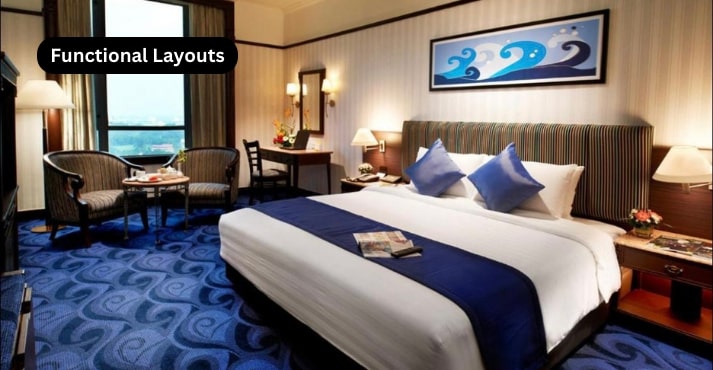
How your hotel room is arranged will significantly impact its functionality. A well-organized and ergonomic room design is essential for guest comfort as it ensures a seamless experience during their stay.
Proper furniture placement, lighting, and amenities enhance functionality, reducing clutter and promoting relaxation.
Ergonomic considerations such as comfortable seating and accessible storage contribute to a sense of ease and well-being, enhancing the guest experience. Functional layout with ergonomics also helps improve hotel operations for the staff and management.
Here are some hotel room design layout ideas to maximize space efficiency and functionality:
Position of Bed
The most essential decision when designing a bedroom layout is where to position the bed. Placing the bed against a focal point, such as a feature wall or a picturesque window, creates a visually appealing centerpiece for the room.
Open Concept Layout
Incorporate an open layout where the sleeping, working, and lounging areas seamlessly flow into one another, optimizing space and creating a sense of spaciousness and flexibility.
Multi-functional Furniture
Utilize furniture that serves dual purposes, such as a sofa bed or a desk with built-in storage compartments, maximizing functionality while minimizing clutter.
Vertical Storage Solutions
Implement vertical shelving units, wall-mounted hooks, and overhead storage to use vertical space efficiently, keeping the floor area clear and maximizing storage capacity.
Sliding Doors
Install sliding doors instead of traditional swing doors to save space, especially in smaller rooms. These doors provide privacy without infringing on the available floor area when opened.
Compact Bathroom Design
Opt for a compact bathroom layout with space-saving fixtures like a corner sink, wall-mounted toilet, and walk-in shower.
2. Aesthetic Themes and Styles
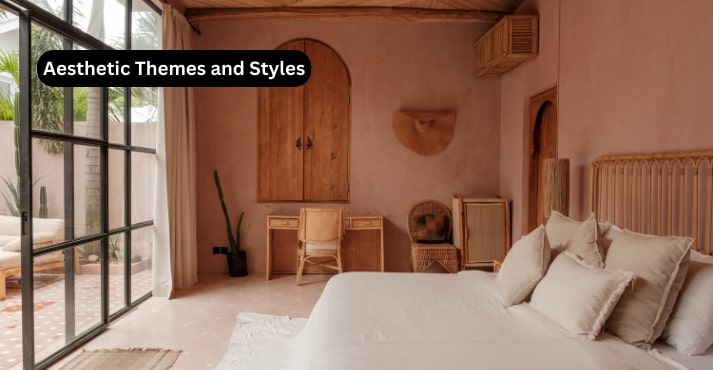
Design aesthetics play a significant role in shaping the ambiance of a hotel room, influencing guests’ perceptions and emotions. Aesthetic elements such as color schemes, lighting choices, and furniture styles evoke specific moods and create memorable atmospheres.
Whether a modern, minimalist design for a sleek and sophisticated feel or a cozy, rustic aesthetic for a warm and inviting ambiance, the hotel room interior design and visual appeal set the tone for guests’ experiences, enhancing comfort and leaving a lasting impression of the hotel.
Five best aesthetic themes and design styles that hotels can incorporate into their rooms:
Contemporary Elegance
Characterized by clean lines, neutral color palettes, and luxurious accents, this style exudes sophistication and refinement, incorporating modern furnishings and minimalist décor to create a timeless and upscale ambiance.
Coastal Retreat
Inspired by beachside living, this theme incorporates light, airy colors, natural textures, and nautical accents to evoke a sense of relaxation and tranquility, inviting guests to unwind in a coastal-inspired oasis.
Urban Chic
Combining industrial elements with contemporary flair, urban chic design features exposed brick walls, sleek furnishings, and bold accents, creating a trendy and cosmopolitan atmosphere that appeals to modern urban travelers.
Vintage Charm
Embracing nostalgia and charm, vintage-themed rooms showcase ornate furnishings, antique accents, and retro décor elements, transporting guests to a bygone era while infusing spaces with character and personality.
Zen Retreat
Inspired by Eastern principles of balance and serenity, Zen-inspired design focuses on simplicity, natural materials, and harmonious arrangements, creating a tranquil and rejuvenating environment conducive to relaxation and mindfulness.
3. Smart Technology Integration
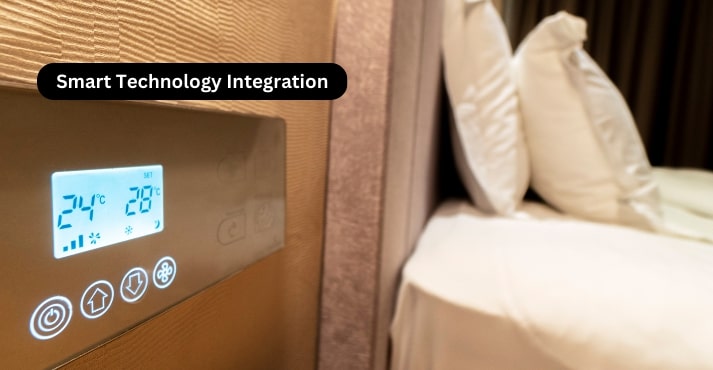
Luxury hotel rooms increasingly integrate innovative technology into room design to elevate guest convenience. Automated controls for lighting, temperature, and entertainment systems empower guests to personalize their environment effortlessly, enhancing comfort and satisfaction.
Here are the top 5 intelligent technology integrations hotels can adopt:
In-Room Tablets
Equipped with interactive interfaces, in-room tablets provide guests access to hotel services, room controls, and local information. They streamline requests for housekeeping, room service, and concierge assistance, offering guests a convenient and efficient way to manage their stay without picking up the phone.
Virtual Concierge
Virtual concierge services utilize AI-powered chatbots or virtual assistants to assist guests with inquiries, recommendations, and bookings. By offering 24/7 support and personalized assistance, these systems enhance guest experiences by providing instant responses to questions and catering to individual preferences without human interaction.
Smart Mirrors
Integrated with touchscreen displays and augmented reality technology, smart mirrors offer guests interactive features such as virtual try-ons for clothing and makeup, weather updates, and fitness tracking. These mirrors enhance convenience and engagement, offering guests additional functionalities beyond traditional reflective surfaces.
IoT Sensors
Internet of Things (IoT) sensors embedded in hotel rooms monitor environmental conditions such as temperature, humidity, and air quality. They automatically adjust settings to optimize comfort levels based on guest preferences, ensuring a pleasant and personalized stay while contributing to energy efficiency and sustainability efforts.
Robotic Room Service
Some hotels deploy butlers or delivery robots to fulfill room service requests. These robots navigate corridors autonomously to deliver amenities, meals, or other items to guests’ rooms, providing a unique and futuristic experience while reducing wait times and minimizing human contact for increased hygiene and safety.
4. Sustainable Design Practices
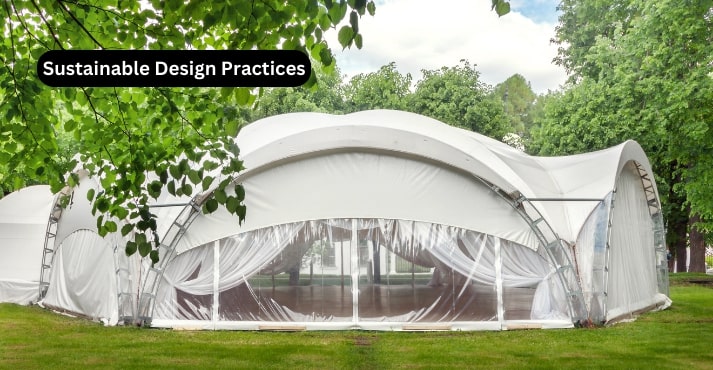
Sustainability in the hospitality industry is on the rise, driven by a growing awareness of sustainability among travelers and hospitality industry professionals.
Hotels are implementing eco-friendly decoration ideas and integrating energy-efficient lighting, water-saving fixtures, and sustainable materials to reduce environmental impact.
Green initiatives appeal to environmentally conscious guests and demonstrate a commitment to responsible use of resources.
Hoteliers can implement eco-friendly and sustainable design ideas for hotel rooms:
Energy-efficient lighting
Incorporating LED bulbs and motion sensors to minimize electricity consumption. Motion sensors automatically switch off lights when rooms are unoccupied, reducing unnecessary electricity usage.
Low-flow water fixtures
Installing faucets, showers, and toilets with low-flow technology limits water flow without compromising performance. For example, aerated showerheads mix air with water to maintain pressure while using less water per minute.
Eco-friendly materials
Hotels opt for sustainable materials like bamboo flooring, reclaimed wood for furniture, and recycled glass countertops. These materials minimize environmental impact by reducing deforestation and waste.
Non-toxic finishes
Using paints, adhesives, and sealants with low VOC levels improves indoor air quality and reduces harmful emissions. For example, hotels may choose paints labeled as low-VOC or zero-VOC for painting walls and surfaces.
Smart thermostats
Programmable thermostats adjust room temperature based on occupancy and time schedules, optimizing energy usage. Hotels may install smart thermostats like Nest or Ecobee, which learn guests’ preferences and adjust settings accordingly.
Biophilic design elements
Natural elements such as plants, living walls, and greenery enhance indoor air quality and promote well-being. For example, hotels may feature indoor gardens or planters filled with air-purifying plants in guest rooms, promoting a sense of relaxation and connection with nature.
5. Luxury and Opulence
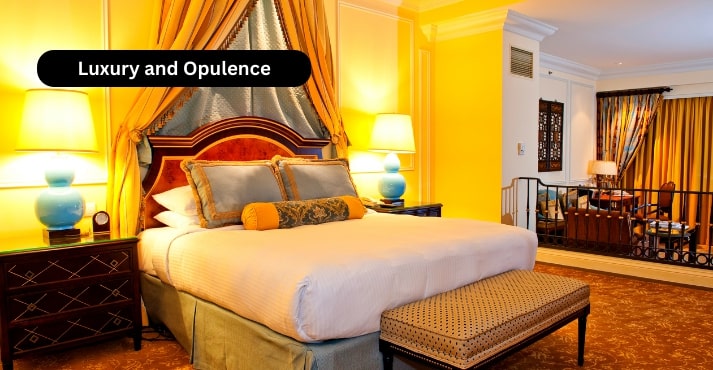
Hotel room designs that evoke a sense of luxury attract hotel customers, elevate their experience, leave a lasting impression, and build loyalty.
Luxurious elements such as plush bedding, upscale furnishings, and lavish amenities create a sense of indulgence and exclusivity, making guests feel pampered and valued.
Moreover, the luxury design enhances the ambiance and aesthetic appeal of the hotel, attracting discerning travelers seeking upscale accommodations.
By prioritizing luxury in room design, hotels can differentiate themselves in a competitive market, demand premium pricing, and deliver unforgettable experiences that exceed guests’ expectations.
Key elements contributing to a luxurious guest experience include:
High-Quality Bedding
Luxurious guest experiences prioritize premium bedding, such as high thread count sheets, plush pillows, and luxurious duvets. These elements ensure guests enjoy a comfortable and restful sleep, enhancing their satisfaction and perception of the hotel’s attention to detail and comfort.
Luxurious Bathrooms
Luxurious bathrooms feature upscale fixtures, such as rainfall showers, deep soaking tubs, and designer toiletries. These amenities offer guests a spa-like experience, promoting relaxation during their stay and adding a touch of indulgence to their daily routines.
Personalized Service
Tailored and attentive service is paramount in creating a luxurious guest experience. From personalized greetings upon arrival to anticipatory service throughout their stay, personalized service makes guests feel valued.
Fine Dining Options
Offering high-quality dining experiences within the hotel elevates the guest experience. From gourmet restaurants to chic bars and lounges, fine dining options provide guests with convenient access to exceptional cuisine and beverages, enhancing their stay.
Exclusive Amenities and Services
Providing exclusive amenities and services, such as private butler service, chauffeured transportation, and access to exclusive facilities like spa and fitness centers, elevate the guest experience to a luxurious level.
6. Local Cultural Influences

Integrating local cultural elements is always great whether you’re looking for big or small hotel design ideas. Incorporating elements of local culture through décor, artwork, and architectural motifs creates a sense of place and belonging for guests.
From traditional textiles and artwork to architectural styles and culinary offerings, cultural influences imbue hotel rooms with a distinct character and charm, allowing guests to immerse themselves in the destination’s heritage and traditions.
Here’s how hotels can incorporate local cultural elements into their room designs:
Traditional Textiles
Incorporating locally-made fabrics like handwoven rugs or embroidered textiles adds a touch of craftsmanship and authenticity to the room decor.
Indigenous Artwork
Displaying paintings, sculptures, or handicrafts created by local artists showcases the region’s artistic heritage and provides guests with a glimpse into its cultural identity.
Architectural Motifs
Incorporating architectural details inspired by local landmarks or historical buildings reflects the region’s unique architectural heritage and creates a sense of place within the hotel room.
Culinary References
Providing locally sourced snacks or beverages in the minibar or offering a menu featuring regional specialties allows guests to experience the flavors and culinary traditions of the destination.
Cultural Symbols
Integrating symbols or motifs with cultural significance, such as traditional patterns or religious icons, adds depth and meaning to the room decor, inviting guests to engage with the local culture.
Historical References
Incorporating elements of local history, such as vintage photographs or artifacts, provides guests with insights into the region’s past and enriches their understanding of its cultural heritage.
7. Innovative Furniture and Fixtures
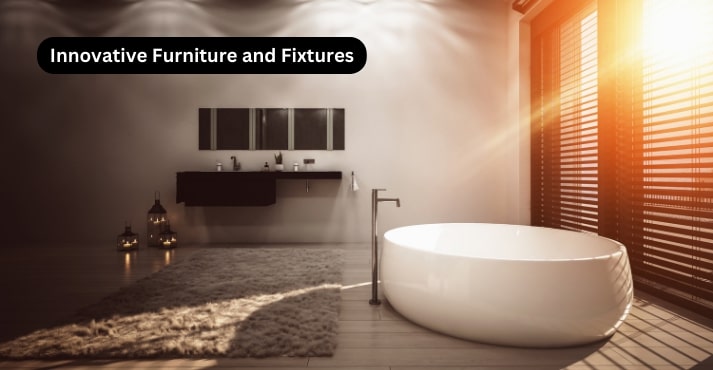
Custom-designed pieces can enhance the guest experience by adding a unique and personalized touch to the hotel environment.
These bespoke elements, whether furniture, artwork, or decor, create a sense of exclusivity and individuality, distinguishing the hotel from competitors and leaving a lasting impression on guests.
Custom-designed pieces also reflect the hotel’s attention to detail and commitment to quality, elevating the ambiance and aesthetic appeal.
Here are some of the unique and innovative furniture and fixtures used in hotel room design:
- Modular furniture systems
- Convertible sofa beds
- Floating bedside tables
- Interactive touchscreen mirrors
- Swiveling TV mounts
- Under-bed storage solutions
- Multi-functional ottomans
- Foldable desks and chairs
- Transparent acrylic bathtub
- Built-in charging stations
By integrating these innovative furniture and fixtures in rooms that align with the hotel’s brand identity and resonate with guests, custom-designed pieces contribute to a memorable and immersive stay, building loyalty and positive word-of-mouth recommendations.
8. Natural Elements and Biophilic Design
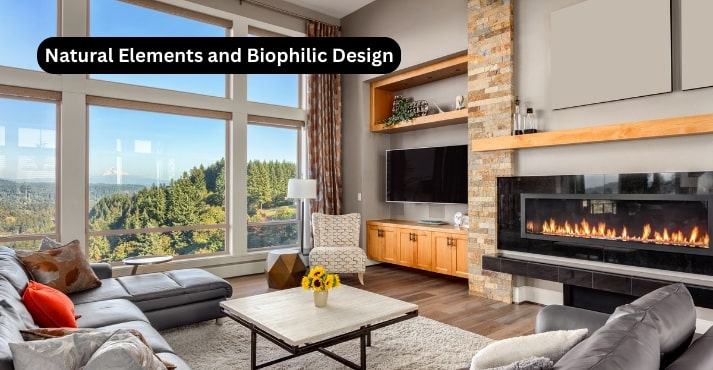
Simple hotel room design can quickly be elevated with natural and biophilic elements. Views of greenery, natural light, and materials like wood and stone evoke a sense of calm and tranquility, enhancing well-being.
Biophilic design elements such as indoor plants and water features mimic natural environments, creating a sense of rejuvenation and boosting mood. By integrating nature into interior spaces, hotel rooms become sanctuaries that provide respite from urban environments.
Here are critical natural elements and biophilic design principles you can add to your hotel rooms:
Indoor Plants
Incorporating potted plants or living walls enhances air quality, reduces stress, and improves cognitive function, creating a calming and inviting atmosphere for guests.
Natural Light
Maximizing access to daylight through large windows or skylights boosts mood, regulates circadian rhythms, and enhances the perception of space and comfort within hotel rooms.
Water Features
Introducing water elements such as indoor fountains or decorative ponds induces relaxation, masks noise, and creates a sense of tranquility, creating a soothing ambiance for guests to unwind.
Organic Materials
Using natural materials like wood, stone, and bamboo in furniture and decor promotes a connection to nature, evokes warmth and authenticity, and enhances the aesthetic appeal of hotel rooms.
Views of Nature
Providing guests with picturesque views of natural landscapes, gardens, or water bodies instills a sense of serenity and promotes mental restoration.
Biomorphic Shapes
Incorporating organic shapes and patterns inspired by nature, such as curving lines or leaf-like designs, evokes a sense of comfort and familiarity.
9. Personalization and Customization
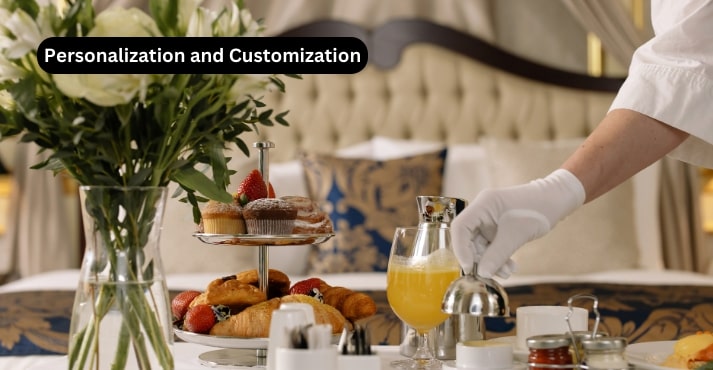
Hotel room interior design ideas that cater to diverse guest preferences through personalization and customization are essential for enhancing guest experience and loyalty.
By offering tailored experiences, hotels acknowledge individual guests’ unique needs and preferences, creating a sense of exclusivity and value. Personalization builds a deeper connection with guests, leading to memorable experiences that exceed expectations.
Moreover, customization empowers guests to create their ideal stay through room preferences, amenities, or activities, resulting in a sense of ownership and satisfaction.
10. Art and Statement Pieces
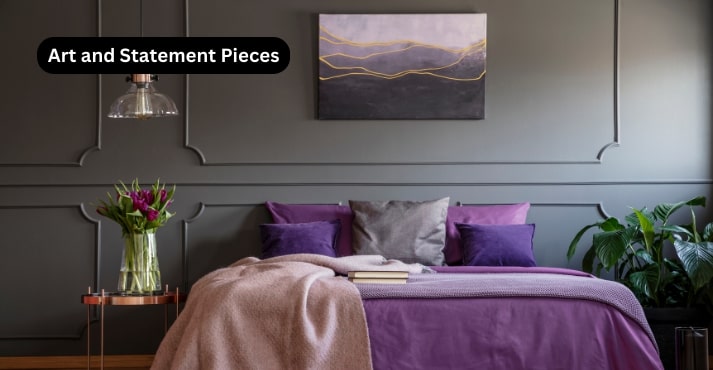
Art and statement pieces add depth, character, and visual interest to the hotel room. From paintings and sculptures to murals and installations, art creates focal points, sparks conversation, and evokes emotions, enriching the ambiance and atmosphere.
Whether it’s contemporary pieces that convey modern sophistication or traditional artworks that reflect cultural heritage, art transforms hotel environments into immersive and captivating experiences, leaving a lasting impression on guests and elevating the aesthetic quality of the space.
Here are some creative ways hotels can use art and statement pieces to create visually striking room designs:
Large-Scale Artwork
Hotels often feature oversized paintings or murals as statement pieces to anchor the room’s design. These works serve as focal points, grabbing attention and infusing the space with color, texture, and personality, creating a visually stunning environment that captivates guests.
Sculptural Installations
Sculptural pieces strategically placed within hotel rooms add dimension and intrigue to the design. Whether it’s a striking sculpture positioned in a corner or a suspended installation above a seating area, these artworks make the room visually impactful, inviting guests to engage with the space.
Gallery Walls
Hotels may curate gallery walls showcasing a collection of art pieces, photographs, or prints. These walls serve as curated galleries, allowing guests to explore various artistic styles and themes while adding visual interest and personality to the room’s decor.
Customized Artwork
Commissioning or integrating customized artwork tailored to the hotel’s brand or the room’s theme enhances the space’s uniqueness and authenticity. Whether it’s a painting, sculpture, or textile explicitly designed for the room, these custom artworks infuse the space with individuality and exclusivity.
11. Lighting Design
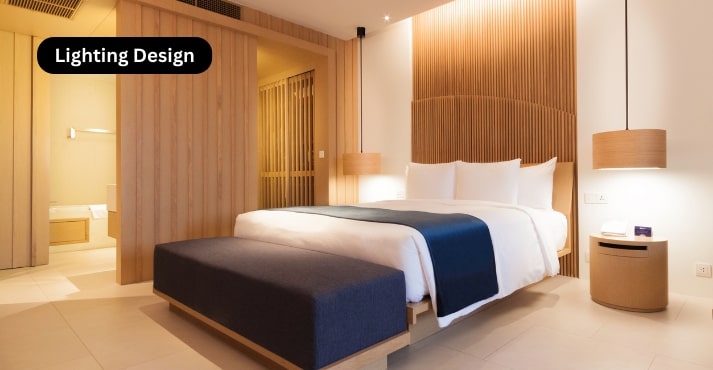
Lighting design plays a crucial role in shaping the mood and ambiance of hotel rooms, influencing guests’ perceptions and experiences. Well-designed lighting enhances comfort, promotes relaxation, and creates a welcoming atmosphere.
Consider these creative and effective lighting designs in hotel rooms:
- Layered Lighting: Combining ambient, task, and accent lighting allows for versatility and ambiance control.
- Intelligent Lighting Controls: Integrating automated systems enables guests to adjust lighting levels and settings easily.
- Mood Lighting Scenes: Pre-programmed lighting scenes cater to different activities or moods, offering a customizable ambiance for relaxation, work, or romance.
- Backlit Headboards: Illuminated headboards add a touch of luxury and sophistication, creating a focal point and enhancing visual appeal.
- Under-bed Lighting: Subtle LED lights under the bed provide a soft glow, enhancing safety and creating a calming ambiance during nighttime.
Moreover, soft, warm lighting creates a cozy, inviting atmosphere, promoting relaxation and comfort. Conversely, bright, natural light gives a sense of freshness and vitality, enhancing alertness and productivity during the day.
12. Multi-Functional Spaces
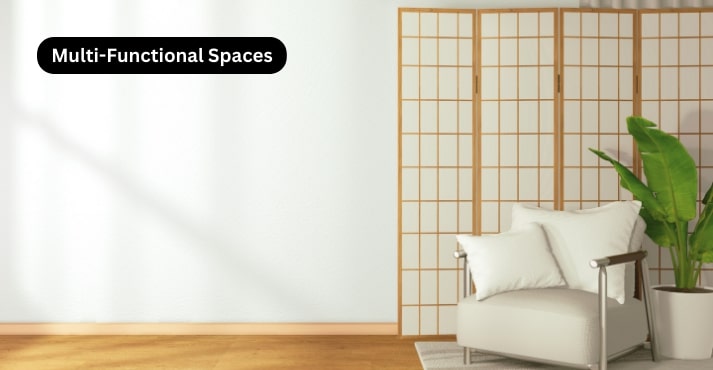
Multi-functional spaces in hotel rooms offer flexibility and versatility, adapting to guests’ varying needs and preferences. Integrating features such as movable partitions, foldable furniture, and convertible seating can transform these spaces from sleeping areas to workspaces or lounges, maximizing functionality without sacrificing comfort.
Whether guests seek relaxation, productivity, or socialization, multi-functional spaces provide adaptable environments that cater to diverse activities and lifestyles.
Tips for creating multi-functional spaces in your hotel room:
- Use modular furniture as it offers flexibility and adaptability, allowing rooms to be easily reconfigured for various purposes without requiring extensive renovations.
- Foldable tables and chairs are popular in hotel chains as they can be stored away when unused, freeing up floor space and accommodating different guest activities.
- Wall-mounted desks maximize floor space while providing a functional workspace for guests.
- Sliding room dividers offer privacy when needed and can be pushed aside to create larger, open spaces, making them ideal for accommodating different group sizes or activities.
- Convertible sofa beds can be used in family suites or extended-stay rooms, providing additional sleeping space without sacrificing comfort or style.
13. Wellness and Relaxation Areas

Spa-like elements and wellness amenities are an open invitation to unwind and a quick way to attract visitors with the promise of transient luxury. It offers guests opportunities for relaxation and rejuvenation.
From luxurious bathrooms with rainfall showers and deep soaking tubs to in-room yoga mats and meditation spaces, these amenities create tranquil sanctuaries that promote physical and mental well-being.
For example, a hotel suite with dedicated relaxation areas, yoga spaces, and in-room spa facilities offering a holistic retreat and promoting relaxation.
Also, nature-inspired retreats with hotel rooms incorporate biophilic design elements, such as natural materials, plants, and views of greenery, creating serene environments that evoke a connection to nature and promote relaxation.
14. Cultural and Historical Themes

Cultural and historical themes in a hotel room are an excellent way to attract tourists to your hotel or travelers who aspire to explore local heritage, traditions, and customs.
Artwork, traditional decor, and historical references can transport guests to different eras or destinations. These themes help guests learn about the destination’s past and develop a connection to the place, leaving a lasting impression of cultural enrichment.
Here are some ways cultural and historical themes can be incorporated into a hotel room design:
Incorporate Local Artifacts
Display historical artifacts or replicas in hotel rooms to showcase the area’s heritage and provide guests with tangible connections to the local culture and history.
Use Indigenous Materials
Utilize materials native to the region in room design, such as wood, stone, or textiles, to evoke a sense of place and authenticity, creating a unique and immersive experience for guests.
Integrate Traditional Patterns
Use traditional patterns or motifs from local art, textiles, or architecture into room décor to reflect the area’s cultural identity and infuse spaces with character and charm.
Tell Local Stories
Incorporate storytelling elements into room design, such as themed artwork, literature, or multimedia presentations, to share captivating tales of the region’s history, legends, and traditions with guests.
15. Technology-Free Retreats
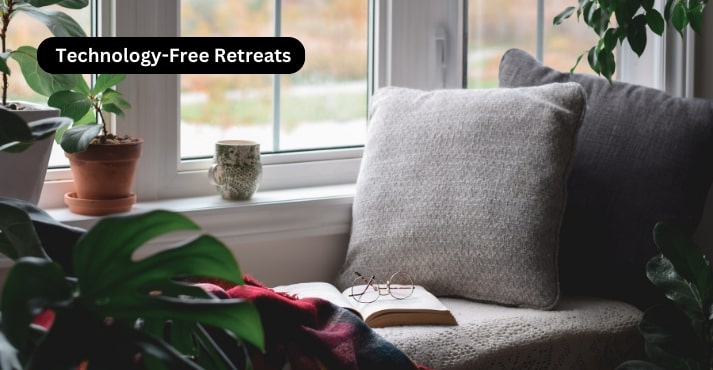
Unplugged room designs offer a retreat from digital distractions, providing guests an environment to unwind and reconnect with themselves and their surroundings.
These hotel rooms promote relaxation, mindfulness, and deepened connections with loved ones. Guests can enjoy uninterrupted tranquility, better sleep quality, and reduced stress levels.
Moreover, unplugged rooms encourage guests to engage in offline activities like reading, journaling, or enjoying nature.
Here are some ways you can integrate technology-free retreats into your hotel room.
No Tech Gadgets
Remove televisions, phones, and digital clocks to minimize electronic distractions, allowing guests to fully disconnect and immerse themselves in the present moment without the temptation of screen time.
Natural Surroundings
Position rooms to offer scenic views of nature, providing guests with a serene backdrop for relaxation and encouraging outdoor activities such as hiking or nature walks.
Reading Nooks
Create cozy reading corners equipped with comfortable seating, a selection of books, and soft lighting, inviting guests to unwind with a good book and escape into literature.
Mindfulness Spaces
Dedicate areas for yoga, meditation, or mindfulness practices, featuring calming decor, soothing music, and essential oils to facilitate mental relaxation and inner peace.
Analog Entertainment
Keep board games, puzzles, and art supplies for guests to engage in offline activities, driving social interactions, creativity, and leisurely enjoyment without technology.
16. Color Palette Selection
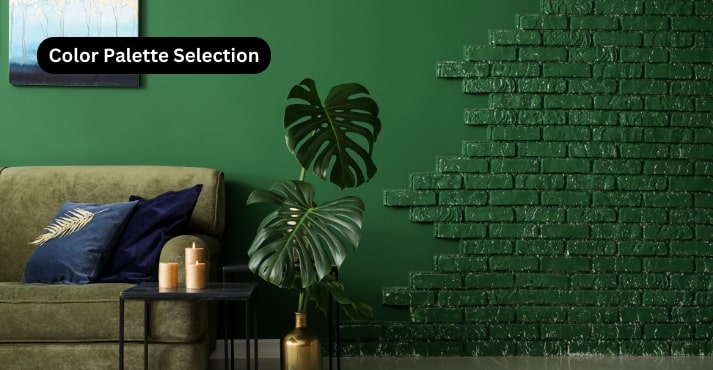
Whether you’re looking for big or small hotel interior design ideas, color palette selection can make all the difference, choose wallpapers, color palettes, tiles, and furnishings that suit the hotel’s architecture.
- Warm Tones: Earthy browns and soft yellows evoke a cozy and welcoming ambiance, while cool hues such as blues and greens promote relaxation and serenity.
- Bold Colors: Reds or oranges energize and stimulate, ideal for vibrant and dynamic spaces.
- Neutral Shades: Whites and grays offer versatility, allowing for timeless elegance or modern minimalism.
Carefully selecting color palettes can shape the guest’s mood and evoke specific emotions. A thoughtful and well-coordinated color palette projects an interpretation of the themes that are brought up in the hotel room.
17. Accessible Design

While exploring hotel room decoration ideas, you must consider accessibility features for guests with disabilities. For example, wheelchair-accessible doorways, bathroom grab bars, and adjustable-height amenities. These design features not only accommodate guests with disabilities but also cater to elderly individuals and families with young children.
5 ways hotel rooms can become accessible for guests with disabilities, older adults, and children:
Wheelchair-Friendly Layout
Spacious room layout with wide doorways and clear pathways allows easy maneuverability for guests using wheelchairs, ensuring independence and accessibility throughout the space.
Roll-In Shower
A barrier-free shower with a roll-in design and grab bars provides safe and convenient bathing facilities for guests with mobility impairments, enhancing comfort and ease of use.
Accessible Bathroom Fixtures
ADA-compliant bathroom fixtures, including sink, toilet, and shower controls, are positioned at accessible heights and equipped with grab bars, ensuring usability and safety for guests with disabilities.
Accessible Beds
Adjustable-height beds with clearance underneath accommodate guests using mobility aids like wheelchairs or walkers, ensuring comfortable and easy access to the sleeping area.
Visual and Tactile Signage
Clear signage with large, high-contrast lettering and tactile elements assists guests with visual impairments in moving around the room and locating amenities independently.
18. Outdoor Spaces and Views
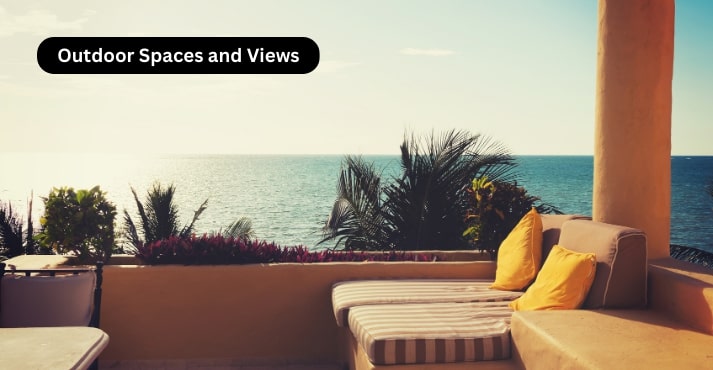
Scenic views of natural landscapes, such as mountains, forests, or waterfronts, enhance the guest experience. Adding outdoor spaces and views to hotel rooms enhances guest experiences by providing access to fresh air and natural light.
5 Tips for Creating Outdoor Spaces and Views:
- Design rooms with large windows or glass doors to maximize natural light.
- Seamless indoor-outdoor transition can create a flow between indoor and outdoor spaces, blurring the boundaries between inside and outside.
- Private balconies or terraces for each room provide guests with personal outdoor retreats to enjoy the scenery and fresh air.
- Thoughtful landscaping with lush vegetation, water features, and comfortable seating creates inviting environments.
- Elevated viewpoints on higher floors or hillside locations offer panoramic vistas, maximizing the impact of the stunning surroundings.
These features attract guests seeking immersive experiences, such as nature enthusiasts or those desiring city views, enhancing the hotel room’s appeal.
19. Personalized Amenities
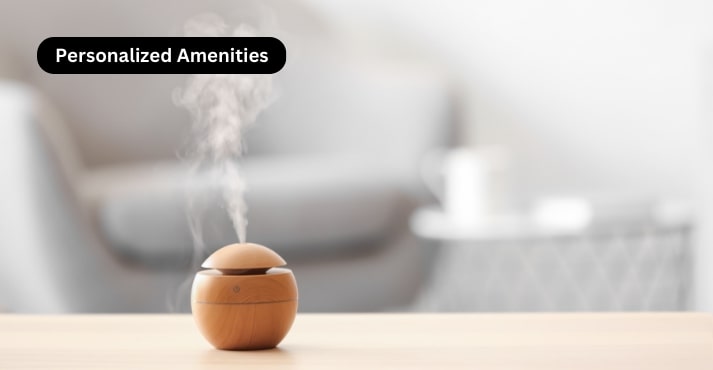
The trend of customized experiences in hotel design focuses on personalized amenities tailored to individual guest preferences. Hotels are moving beyond one-size-fits-all approaches, offering customized room amenities, preferred bedding options, and curated dining experiences.
Here are the most common personalized amenities based on guest preferences, offered by the hotels:
- Preferred room temperature settings
- Pillow and bedding preferences (e.g., firmness, type of pillows)
- Room fragrance or aromatherapy options
- Customized mini-bar selections (e.g., favorite snacks, beverages)
- Personalized in-room entertainment options (e.g., streaming services, gaming consoles)
By leveraging guest data and technology, hotels create memorable and meaningful experiences that cater to specific tastes and preferences. This trend not only enhances guest satisfaction and loyalty but also delivers exceptional hospitality experiences and creates lasting memories for every guest.
20. Guest Feedback and Adaptability

By listening to guests’ suggestions and addressing their concerns, hotels gain valuable insights into areas for improvement, helping hotels identify trends, preferences, and emerging needs.
Guest feedback can be conducted through surveys, reviews, and direct communication channels to understand preferences and identify areas for improvement.
With these insights into room design updates, hotels can ensure that future guests enjoy enhanced comfort, functionality, and satisfaction, building long-term relationships and positive word-of-mouth recommendations.
Hotels adapt their designs based on guest preferences and trends by continuously gathering and analyzing guest feedback, monitoring industry trends, and incorporating innovative solutions into their design processes.
Conclusion
Exceptional hotel room design ideas can give a sense of immersion and deliver a memorable experience they want to repeat. From the largest hotel chains to small hotels, room designs are essential in creating environments that cater to diverse guest preferences and needs.
Whether you plan to leverage technology for convenience or embrace wellness elements for relaxation, each design choice should elevate the guest’s comfort. Simplistic design details with functional layouts create an inviting, modern, yet intelligent hotel room.
With the right ideas for the color palette, bed frame, bedding, and the all-important furniture and fixtures or ottoman at the foot of the bed, any bedroom can feel like a five-star hotel.
Thoughtful and guest-centric hotel room designs make your hotel a destination of choice, where guests not only come to unwind but also to immerse themselves in unique experiences, create lasting memories, and feel genuinely cared for throughout their stay journey.
Lastly, hoteliers must participate in the HORECA trade show to get ideas and inspiration and connect with the best interior designers.













